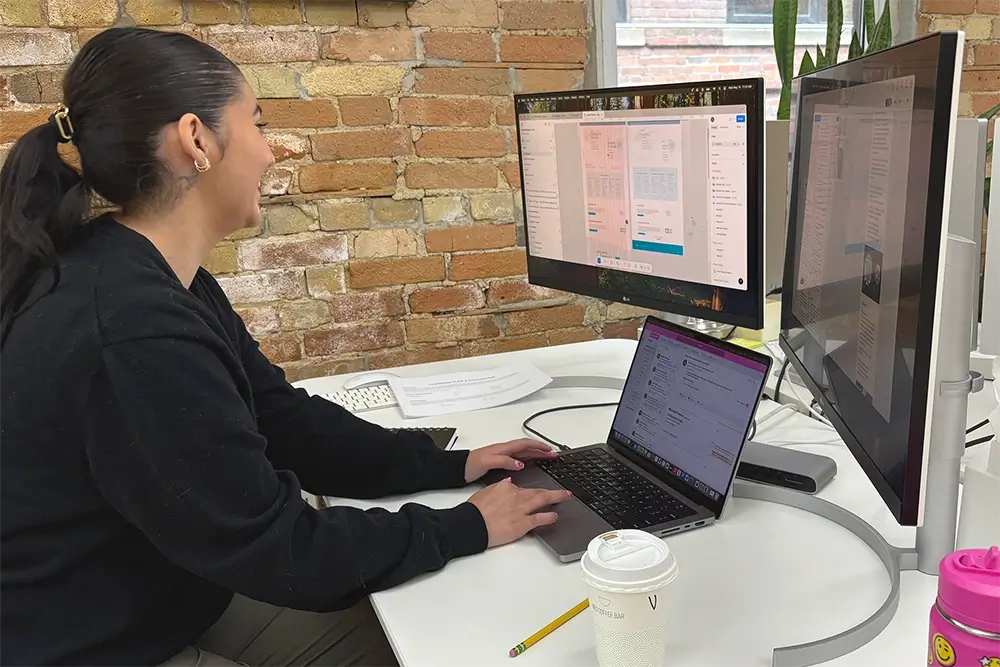Posted on: 2 October 2025

Interning 101: What I learned at Akendi
As I wrap up my UX internship at Akendi, I’ve taken time to reflect on how much I’ve grown over the past few months, not just in terms of design skills, but in how I approach problems, collaborate with others, and think like a UX designer. From participating in UX workshops and contributing to client projects to leading an internal research project, I’ve had opportunities to become more familiar with the research and design process.
Here are some lessons I’ve learned that have shaped my experience this summer:
1. Ask More Questions
Interning is all about learning, and asking questions is about learning. It was intimidating at first, especially when I was surrounded by experienced professionals. I felt hesitant to ask trivial questions (like “Why isn’t the coffee machine working?”, which, in my case, it was just switched off). However, getting over those small and silly questions helped me feel more comfortable, and eventually I started to become confident enough to ask the more important ones.
All jokes aside, in UX, asking questions is a crucial factor in how we design. It’s how we learn about users, uncover pain points, and design solutions that truly meet their needs. Asking questions is hard, and asking good questions can be even harder, but like any skill, I hope I can practice becoming better over time. Developing the skill of asking thoughtful questions is something I’ll carry with me moving forward and continue to practice as I go into my fourth year of college.
2. Step Out of your Comfort Zone
One of the most valuable lessons I learned was to embrace the discomfort of trying something new. I’ve learned that internships are a safe space to make mistakes and grow from them.
At Akendi, I was assigned a solo internal research project. At first, I was nervous to take this task on. I didn’t feel like I had enough knowledge or experience to lead a project on my own, especially one I’d eventually have to present to management. In the end, I delivered on something I thought I wouldn’t be able to do, but I learned a lot, grew my confidence, and delivered something meaningful.
While working on this project, I realized that not only did I have to step out of my comfort zone, but my work also had to step out of its comfort zone. Initially, I realized my findings came outside the scope of my initial research goal and hypothesis. I was nervous that what I found was not what my management wanted to hear. I learned that including these findings helped demonstrate a deeper understanding of the user experience and opened opportunities the team hadn’t considered. I learned that sometimes the best opportunities happen unexpectedly.
3. Think with the End in Mind
A big part of growing as a designer is learning to understand what you are trying to achieve in your work and what the end goal is. During my internship, I started to get a better sense of how long tasks take, how to prioritize effectively, and how to meet the standards and goals my workplace (and myself) have set.
This summer, I got to learn that every design or research task should be tied to a clear goal: What am I trying to learn? What problem am I solving? What value am I delivering to the client or user? Without clear goals and standards, it’s easy to lose focus or worse, create something that looks good but doesn’t solve the real problem. Whether my focus was on designing or running a user interview, thinking with the end in mind was key to knowing that I was learning how to create great products.
4. Learn from your Team Members
While I interned at Akendi, I found myself constantly learning from just being around skilled professionals. I had the chance to sit in on usability testing, observe client workshops, and receive feedback on tasks or projects that were assigned to me. From simply being able to observe these activities, I was able to experience and learn things about UX that went beyond a classroom education.
Being a part of a collaborative environment improved my skills and allowed for better brainstorming between me and some team members. For instance, being able to ask for feedback on a screen that I designed led me to learn how to improve my design skills for digital products, how to talk about my work to others, and also how to defend my design decisions.
When thinking about how this lesson translates to UX, I think about how we look at feedback to help with our research or design decisions. From listening to user pain points to gathering insights from usability testing, being able to know how to communicate, listen, and then implement a solution for users is all a part of UX and is something that I’ve learned how to do by just collaborating and communicating with the team.
Looking Ahead
I could have talked about all the new Figma tricks I picked up or the user research methods I observed from team members; however, what I think matters most is how this experience has shaped me as a designer. My time at Akendi has given me not just technical knowledge, but also the mindset and confidence to keep growing in this field. Even though my time at Akendi was short, I noticed how the company and team produces an environment where learning, collaborating, and asking for help are encouraged. UX is always evolving and changing. Being met with this environment just makes sense in terms of creating successful strategies and solutions for any product or service.
As I head into my final year of school and begin to think about my future career, I’ll carry forward the lessons I’ve learned here: stay curious about things, take risks in your work, think with a goal in mind, and be ready to continuously learn from others!
Related Articles



